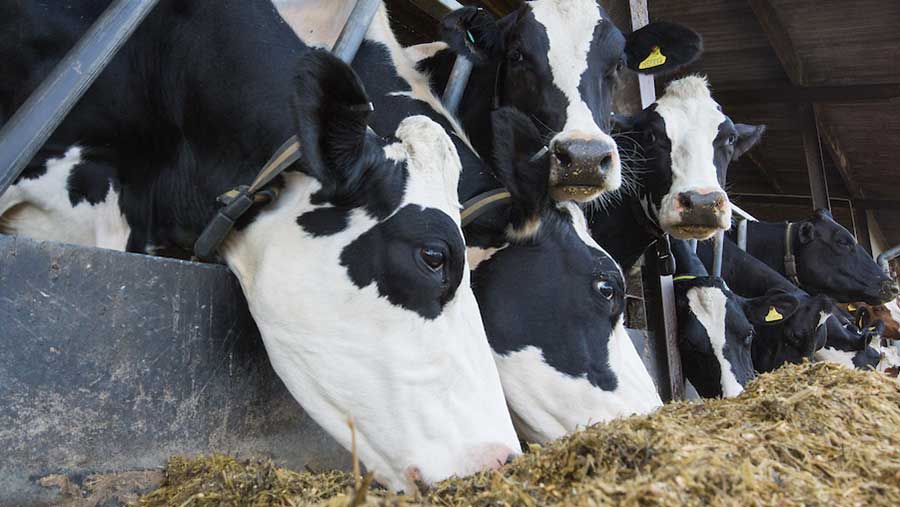Advice on using yeast, buffers or rumen conditioners
 © Tim Scrivener
© Tim Scrivener The question of when to use a yeast, buffer or rumen conditioner is one that leaves many dairy producers confused.
The key, according to Derek McIlmoyle, AB Vista’s technical director for GB and Ireland, is to start by assessing the level and type of pressure the rumen is under.
“Feed efficiency is a high priority for most milk producers at the moment,” he says.
“So in situations where yeasts, buffers and rumen conditioners can help create a rumen environment that improves fermentation efficiency, they have a role to play.”
Optimum rumen function
The rumen functions best when pH range is closest to 6.0. Fibre digestion is compromised any time rumen pH drops below 5.8.
A high rumen pH can also be detrimental, and another threat to good fermentation efficiency is oxygen in the rumen, which can build up when the rumen is under a lot of pressure from rapidly fermenting feeds and acidic silages.
How products work
Should I use a yeast?
A trial carried out at Schothorst Feed Research (SFR) in the Netherlands found that in cows fed a typical diet, combining a yeast with a rumen conditioner produced a 3% increase in feed efficiency compared to using a yeast alone.
Buffers and rumen conditioners can help re-establish rumen pH within the ideal 5.8-6.2 range.
Yeasts deliver feed efficiency gains by generally improving conditions in the rumen, with greatest effect when rumen pH is already close to optimum.
“Yeasts will have some effect on rumen pH, but that’s not their main function,” Dr McIlmoyle says.
“However, by mopping up excess oxygen in the rumen, reducing populations of detrimental microbes and encouraging proliferation of those responsible for fibre digestion, yeasts will help maximise production from the ration.”
Do you need to use them?
Step one: Rumen stability scoring
Start by evaluating rumen stability, using the values in the “Rumen stability scoring table” (below) to allocate a score of one, two or three for the six assessment categories depending on whether each represents a low, medium or high risk factor.
The total score can then be checked against the information at the bottom of the table to determine whether a yeast is likely to be beneficial or not.
The biggest benefits will come where herds have a rumen stability score between nine and 12.
Rumen stability scoring table |
|||
|
Low risk |
Medium risk |
High risk |
|
|
Score for each measure |
1 |
2 |
3 |
|
Average lactation yield (litre/cow) |
< 6,500 |
6,500-8,000 |
> 8,000 |
|
Daily dry matter intake (kg/cow) |
< 20kg |
20-23kg |
> 23kg |
|
% concentrate in diet (DM basis) |
< 40% |
40-50% |
> 60% |
|
Undigested grain/ fibre in dung |
Low |
Medium |
High |
|
Cereal silage as % total forage |
< 25% |
25-45% |
> 45% |
|
Grass silage PAL2 score |
< 850 |
850-1,000 |
> 1,000 |
|
Evaluating total score |
|||
|
< 9 |
Yeast less likely to be beneficial |
||
|
9-12 |
Yeast likely to be beneficial |
||
|
12-15 |
Yeast highly likely to be beneficial |
||
|
> 15 |
Consider yeast with a rumen conditioner |
||
Step two: What the score tells you
For lower-yielding herds, where the rumen is under less pressure, rations are well-balanced and the main forage is high-fibre grass silage, rumen function is likely to already be good and there is little to gain from adding a yeast.
Dr McIlmoyle says if the rumen stability score is more than 15, it shows cows are facing a severe acidosis challenge and the priority should be to correct rumen pH using a buffer or rumen conditioner.
Even if it’s clear using a buffer or rumen conditioner will help stabilise rumen pH, there are still choices to be made.
The first is whether to use traditional chemical buffering agents such as sodium bicarbonate and magnesium oxide, or a dedicated slow-release rumen conditioner.
“It’s important to understand the differences between the various options available,” explains Dr McIlmoyle.
“Buffers and rumen conditioners are both capable of improving rumen pH, but the research has shown that rumen conditioners are more effective in increasing the amount of time rumen conditions remain optimal.
“It has also been suggested the buffer sodium bicarbonate, for example, may raise rumen pH by simply increasing the rate at which feed passes through the rumen.
“This cuts the amount of rapidly available feed fermented in the rumen, but at the expense of feed efficiency.”
Rumen conditioner efficacy
Care is also needed when choosing which rumen conditioner to use.
One study investigating conditioner efficacy found many failed to become active – known as the ionisation point – until the pH had dropped below the point at which fibre digestion is compromised in the rumen (pH 5.8), or even below the threshold for acidosis (pH 5.5).
“A separate, direct comparison between two of the leading conditioners on the market also found an 88% difference in acid neutralising capacity,” Dr McIlmoyle adds.
“Make sure you do your homework before making any choices about which supplements to use.”
